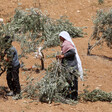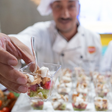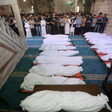The Electronic Intifada 12 June 2021
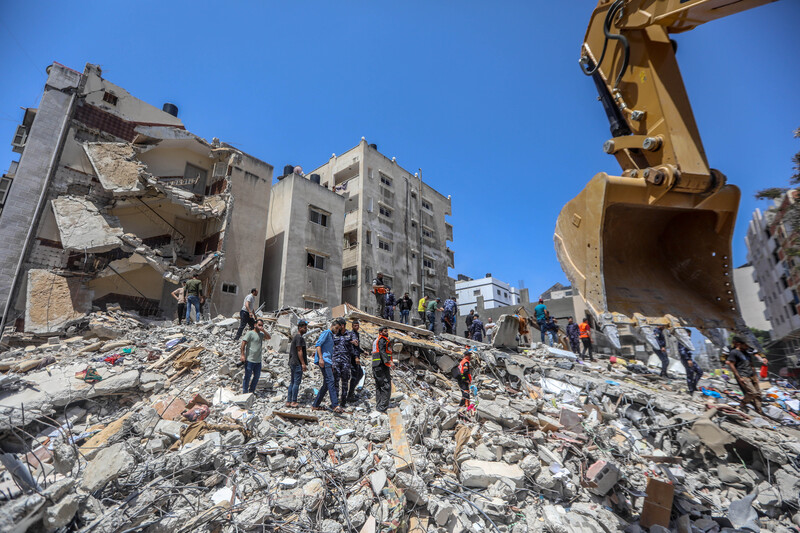
Palestinians inspect the rubble of destroyed homes on al-Wihda street in Gaza City on 16 May.
ActiveStillsIsrael’s 11-day bombardment of Gaza in May left the coastal enclave in ruins… once again.
More than 250 Palestinians were killed, including at least 67 children.
About half of those killed were civilians, according to UN monitoring group OCHA, and 245 of them were killed by Israeli fire. Some were killed as a result of rockets fired from Gaza that fell short.
Multiple generations of multiple Palestinian families were in some cases almost completely wiped out. Fourteen families lost three or more members in a single attack, while 19 families lost two or more members.
In some instances, only one member of a nuclear family survived. In one case, 21 members of the same family were killed.
This is Part I of a series that documents the names, faces and stories of some of the victims of Israel’s May 2021 attack on Gaza. Read Part II here and Part III here.
On 16 May, Israel’s offensive on Gaza had entered its seventh day.
Just after midnight, Israeli warplanes began bombing two residential buildings and the surrounding area on two parallel roads – al-Wihda street and the Egyptian Embassy street – in central Gaza City.
For about an hour, bombs rained down on the area. The homes eventually collapsed on the families living there.
With surrounding streets severely damaged, it was difficult for ambulances from the nearby al-Shifa hospital to reach the site of the bombing.
Palestinian rescue teams spent days pulling bodies from under the rubble, dead and alive.
It was “one of the most horrific crimes” of Israel’s 11-day massacre in Gaza during May, Euro-Med Human Rights Monitor said at the time.
At least 44 Palestinians, including 18 children, were killed in the 16 May massacre on al-Wihda street.
Multiple generations of multiple families were obliterated.
Here are some of their stories.
Ishkintna family, five members killed
Riyad Ishkintna survived against all odds.
He was stuck for hours under a slab of concrete of what used to be his home, but which had been reduced completely to rubble.
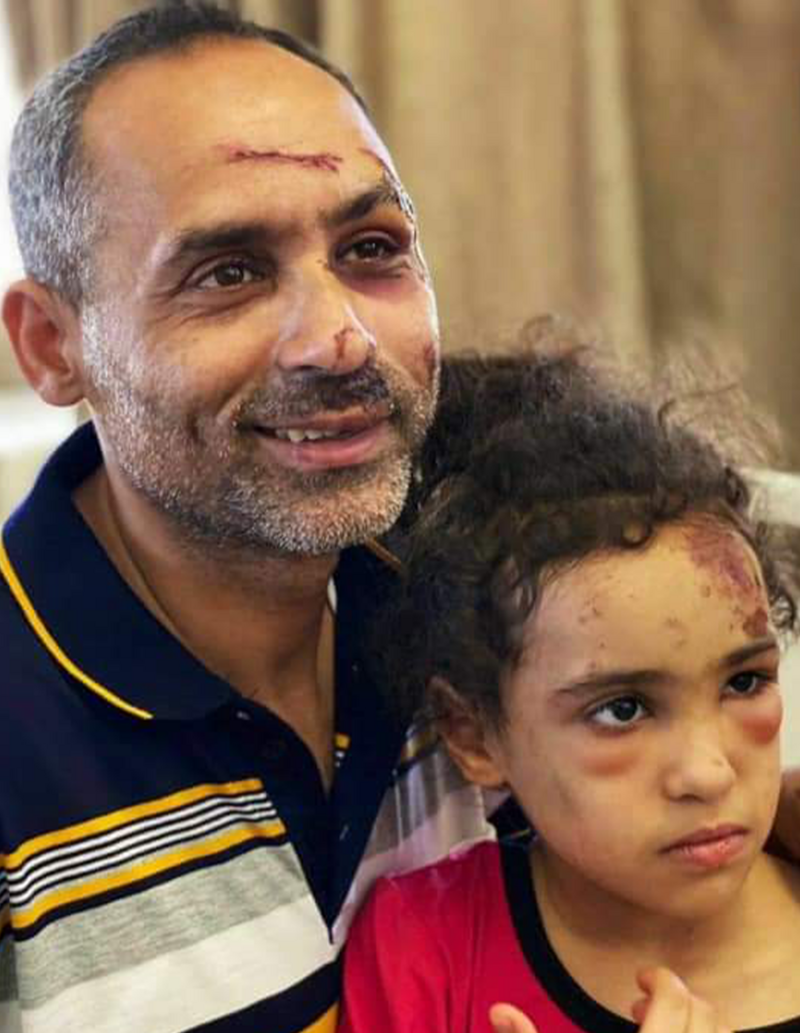
Riyad Ishkintna and his only surviving child Suzie. (Facebook)
Riyad was watching television in his living room and his wife was tucking their children into bed when Israeli warplanes began to fire missiles at their neighborhood.
The family had moved to the building because its inhabitants were “doctors, respectable people and educated people” who “don’t have any weapons,” he told Turkish satellite channel TRT World.
His home – which he described as a place of “comfort” and “safety” – was targeted by Israeli missiles, killing almost every single member of his nuclear family.
He was rescued from the rubble by a team of medics and volunteers hours after the blast and emerged covered in bloodstains and dust and missing a finger.
Still, he emerged holding a victory sign.
In the following hours, he slowly learned that all but one member of his nuclear family had been killed in the Israeli air raid.
His wife, 29-year-old Abir Ishkintna and their children Dana, 9, Lana, 5, Yahya, 4 and 2-year-old Zein, had all been killed.
“I was listening to their voices beneath the rubble. I heard Dana and Zein calling, ‘Dad! Dad!’ before their voices faded and then I realized they had died,” he told The Associated Press.
“I learned about their deaths one after another,” he told AP, because doctors tried to withhold the truth as long as possible to ease the shock.
Riyad’s 7-year-old daughter Suzie Ishkintna was pulled out of the rubble alive.
“This daughter is the only survivor. The only one of my children rescued alive from under the rubble,” Riyad told TRT World’s camera, with Suzie sitting quietly next to him before the rubble of their destroyed home.
“I buried my children and my wife here,” he said.

The four Ishkintna children who were killed in the 16 May massacre. From the left, Dana, 9, Lana, 4, Yahya, 4, and their 2-year-old brother Zein. (Flickr)
Dana, his 9-year-old daughter killed in the strike, was one of 11 children killed in Israeli attacks on Gaza in May who received care for past trauma they’ve endured as part of a psychological health program run by the Norwegian Refugee Council, a humanitarian body.
“They are now gone, killed with their families, buried with their dreams and the nightmares that haunted them,” the group’s secretary general Jan Egeland said.
AP reported that Suzie “hardly speaks or eats.” Doctors said she is severely traumatized and shocked, and has entered into a deep depression.
“I pray that I will live a good life with my only daughter, create a happy future for her, help her pursue the dreams of her brothers and sisters who are buried beneath the ground,” Riyad told TRT World.
“I will do my best to help her with even the simplest things, because she is the only person left for me in this world.”
Al-Qawlaq family, 21 members killed
Multiple generations of the al-Qawlaq family – at least 21 people – were also killed in the same attack early that fateful 16 May morning.
The youngest, Qusay Sameh al-Qawlaq, was just 6 months old. The oldest was 90-year-old Amin Muhammad al-Qawlaq.
Eight children of the al-Qawlaq family were killed in the strikes.
Four of them were also receiving psychological treatment for trauma they’ve experienced in the past. Rula Muhammad al-Qawlaq, 5, and her older sisters, Yara, 9, and Hala, 12, were in the program, as well as their 14-year-old relative Hana Shukri al-Qawlaq.
The kindergarten in Gaza City that Rula al-Qawlaq and her neighbor Lana Ishkintna attended mourned the girls in a Facebook post.
Three-year-old Adam Izzat al-Qawlaq, Zeid Izzat al-Qawlaq, 8 and Ahmad Shukri al-Qawlaq, 15, were the other children killed in the attack.
Other members of the family who perished:
- Ayat Ibrahim al-Qawlaq, 19
- Abd al-Hamid Fawaz al-Qawlaq, 22
- Taher Shukri al-Qawlaq, 23
- Sameh Fawaz al-Qawlaq, 28
- Riham Fawaz al-Qawlaq, 32
- Doa Omar al-Qawlaq, 38
- Muhammad Muin al-Qawlaq, 41
- Amal Jamil al-Qawlaq, 42
- Izzat Muin al-Qawlaq, 44
- Baha Amin al-Qawlaq, 48
- Fawaz Amin al-Qawlaq, 62
- Saadiya Yusef al-Qawlaq, 84
Al-Ifranji family, five members killed
Four al-Ifranji siblings were killed in the al-Wihda street massacre.
The children were Dima Rami al-Ifranji, 15, and her three siblings 13-year-old Yazan, 11-year-old Mira and Ameer, aged 9.

The al-Ifranji children killed in the 16 May massacre. From left to right, Dima, 15, Yazan, 13, Mira, 11 and 9-year-old Ameer. (Flickr)
Dima and Mira were also receiving therapy for trauma endured in the past.
Forty-one-year-old Raja Subhi al-Ifranji also died in the same attack.
Abu al-Ouf family, 10 members killed
The al-Wihda street massacre claimed several generations of the Abu al-Ouf family.
Dr. Ayman Tawfiq Abu al-Ouf, head of internal medicine at al-Shifa hospital, died along with his wife Reem Ahmad Abu al-Ouf, 40, and their children Tala, 13, and Tawfiq, 17.
Dr. Ayman had left the al-Shifa hospital that night after a long shift of overseeing COVID-19 patients in the intensive care unit. He returned to his workplace as another casualty of Israel’s violence just hours later, his colleague told The Electronic Intifada.
Subhiya Ismail Abu al-Ouf, 73, and her brother 79-year-old Tawfiq Ismail Abu al-Ouf were also killed in the blast, along with 82-year-old Majdiya Khalil Abu al-Ouf.
Sisters Shayma Alaa Abu al-Ouf, 21 and Rawan Alaa Abu al-Ouf, 19 were also killed in the blast. Their mother, Diana Ziyad al-Yaziji, succumbed to her wounds weeks later.
“What we’re feeling is indescribable. Words do not suffice,” Haya Abu al-Ouf, who lost ten relatives in the massacre, told local media.
“Gather us in one spot and bomb us all at once,” she continued.“But this, what you’re doing to us is torture. It’s inhumane. The psychological war we are experiencing won’t be resolved with a lifetime of therapy.”
Muin Ahmad al-Alul, 66, another doctor and a colleague of Dr. Ayman, also died in the same attack. His wife and daughter survived the bombing.
Two other men, Luay Muhammad Odeh, 54 and Hazim Adel al-Qame, 48, were killed as well.
Tamara Nassar is associate editor of The Electronic Intifada.

